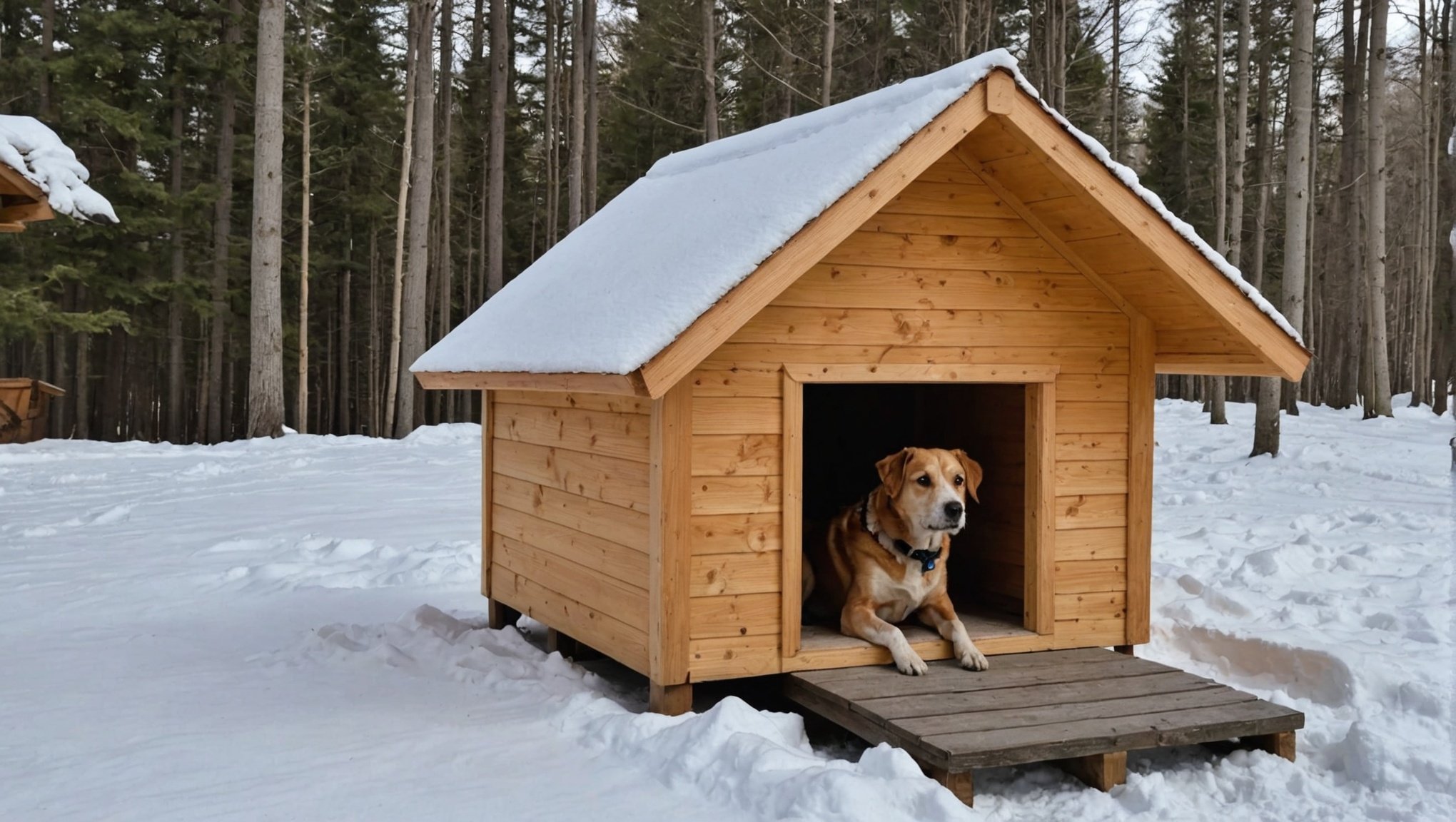Ultimate Guide to Insulating Your Dog House for Severe Winter Conditions
As the winter months approach, ensuring your dog’s comfort and safety becomes a top priority. One of the most crucial steps in keeping your furry friend warm and cozy is to properly insulate their dog house. Here’s a comprehensive guide to help you make your dog house a warm and comfortable retreat for your pet.
Understanding the Importance of Insulation
Insulation is not just a luxury for your dog; it is a necessity, especially during severe winter conditions. Dogs, like humans, feel the cold, and some breeds are more susceptible to it than others.
This might interest you : Essential Tips for Safely Giving Medication to Your Trusting Senior Rabbit
“Dogs with long and shaggy coats will be better insulated from the cold than breeds that have short, thin or tight coats,” explains Dr. Jessica Romine, a board-certified internal medicine veterinarian at BluePearl Pet Hospital in Southfield, Michigan. “Breeds like Siberian Huskies and Alaskan Malamutes are well-acclimated to the cold, but others like Bulldogs and Chihuahuas need extra care to stay warm”.
Choosing the Right Dog House
When it comes to selecting a dog house, insulation should be your primary concern. Here are some key features to look for:
Additional reading : Mastering Parrot Socialization: Essential Tips for Connecting with Humans and Fostering Friendships among Birds
Insulated Walls, Roof, and Floor
An ideal dog house should have insulation on all six sides, including the walls, roof, and floor. This ensures that your dog stays warm even in sub-zero temperatures. The GUTINNEEN Insulated Outdoor Dog Kennel, for example, features a combination of wood, iron frame, and an insulated liner that locks in the temperature and keeps your pet warm.
Weather-Resistant Materials
The dog house should be made from weather-resistant materials such as waterproof asphalt roofs, PVC strips, and plastic feet. These materials protect the house from rain, snow, and harsh sunlight.
Metal Frame and Durable Construction
A strong metal frame can prevent destruction and chewing from your dog. The GUTINNEEN dog house, for instance, has an all-around metal frame that adds to its durability.
DIY Insulation Tips for Your Dog House
If you prefer to build or modify your dog house yourself, here are some DIY tips to ensure it is well-insulated:
Use Foam Boards
Foam boards are excellent insulators and can be easily installed in the walls, floor, and roof of your dog house. They provide good thermal insulation and are relatively inexpensive.
Add a Thermal Liner
A thermal liner can significantly enhance the coziness of your dog house. You can use materials like sponge insulation or even old blankets to line the interior of the house.
Elevate the Dog House
Raising the dog house off the ground helps to keep it dry and warm. This can be done using wooden blocks or a raised platform. This also improves air circulation and makes cleaning easier.
Practical Steps to Insulate Your Dog House
Here are some practical steps you can take to ensure your dog house is well-insulated:
Step 1: Select a Sheltered Location
Place the dog house in a sheltered location that is protected from wind, rain, and snow. This could be under a tree, against a wall, or in a covered area.
Step 2: Use Insulating Materials
Fill the dog house with clean, dry blankets or a self-warming dog bed. These materials help to retain your dog’s body heat and keep them warm.
Step 3: Ensure Proper Ventilation
While insulation is crucial, proper ventilation is also important to prevent moisture buildup. Ensure that the dog house has some ventilation to keep the air fresh and dry.
Step 4: Maintain the Dog House
Regularly clean and maintain the dog house to ensure it remains warm and comfortable. This includes laundering the blankets and checking for any damage to the structure.
Detailed List of Insulation Materials and Tips
Here is a detailed list of materials and tips to help you insulate your dog house effectively:
- Foam Boards: Excellent thermal insulators that can be used in the walls, floor, and roof.
- Thermal Liner: Use materials like sponge insulation or old blankets to line the interior of the house.
- Insulated Dog Beds: Use self-warming dog beds or beds with thick, insulating materials like memory foam or orthopedic foam.
- Blankets and Bedding: Fill the dog house with clean, dry blankets. Raise the bed off the ground and add additional blankets for warmth and comfort.
- Weather-Resistant Coatings: Apply weather-resistant coatings to the exterior of the dog house to protect it from rain and snow.
- Elevated Platform: Raise the dog house off the ground to improve air circulation and keep it dry.
Comparative Table of Insulated Dog Houses
Here is a comparative table of some popular insulated dog houses to help you make an informed decision:
| Dog House Model | Insulation Features | Materials | Weather Resistance | Additional Features |
|---|---|---|---|---|
| GUTINNEEN Insulated Outdoor Dog Kennel | 6-sided thermal liner, foam boards | Wood, iron frame | Waterproof asphalt roof, PVC strips, plastic feet | Metal frame, durable construction |
| Sugar & Cloth Insulated Dog House with Deck | Insulated walls, roof, and floor | Wood | Shed roof for water runoff | Spacious deck, self-warming bed |
| Shardo Ultimate Insulated Dog House | Foam boards, thermal liner | Wood, metal frame | Sloped roof for water runoff | Raised platform, ventilation |
| EzyDog Insulated Kennel | Insulated walls and roof | Wood, waterproof coating | Waterproof outer shell | Reflective stitching for visibility |
Keeping Your Dog Warm and Safe Outside
In addition to insulating the dog house, there are several other ways to keep your dog warm and safe during the winter months:
Dressing Your Dog
For short-haired breeds or dogs that spend a lot of time outside, a winter coat or jacket can be a wise investment. The EzyDog Element Jacket, for example, has a waterproof outer shell and a soft inside fleece to keep your dog dry and warm.
Using a Warming Harness
A warming dog harness with a gel pack can help keep your dog warm, especially in areas with heavy snow and sub-zero temperatures. These harnesses work by using your dog’s body heat to warm the pack.
Letting Their Fur Grow
Allowing your dog’s fur to grow a bit longer during the winter months can provide natural insulation. “Dog hair is a wonderful insulator, and many breeds have a double coat, with an outer layer of guard hairs to protect from the elements and a downy underlayer to contain heat,” advises Dr. Jessica Romine.
Insulating your dog house is a crucial step in ensuring your furry friend stays warm and comfortable during the severe winter conditions. By choosing the right materials, following practical steps, and using additional tips like dressing your dog and providing a warming harness, you can make your dog’s winter months much more comfortable.
Remember, every small detail counts, from the type of insulation you use to the location of the dog house. By taking these steps, you can help ensure your dog remains warm, safe, and happy throughout the winter.
As a pet owner, it’s your responsibility to make sure your dog has a warm and cozy home. With the right insulation and care, you can provide your furry friend with the comfort they deserve, even in the coldest of winters.







